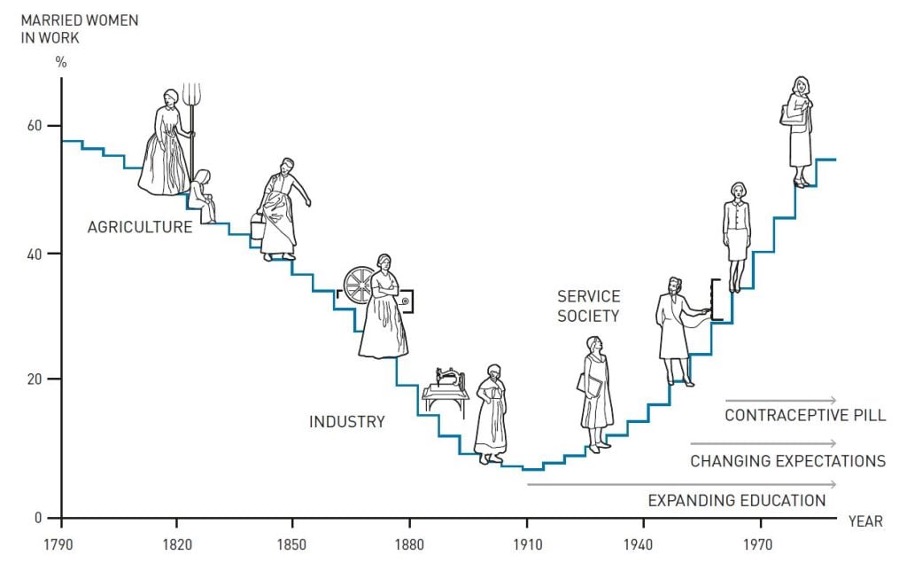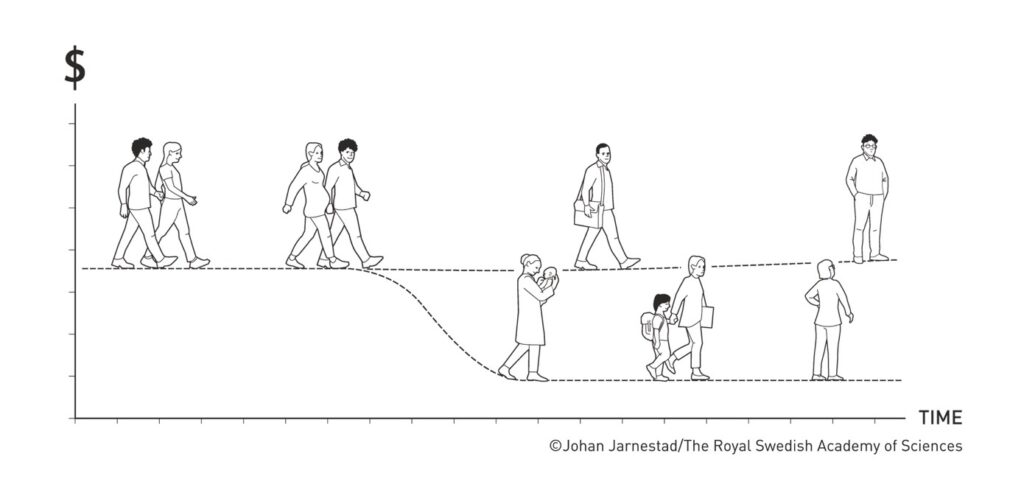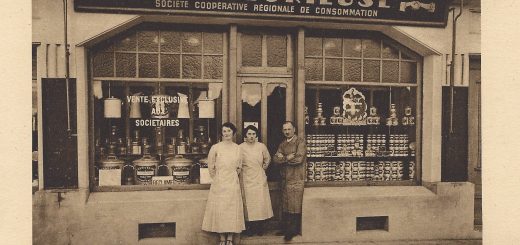The New Economics Nobel Laureate, Claudia Goldin!

The Sveriges Riksbank Prize in Economic Sciences in Memory of Alfred Nobel 2023 goes to Claudia Goldin – the first women ever to get tenure at Harvard’s Economics Department in 1990 and the first women to win the prize on her own. The image of an economist will now change even more. There is reason to celebrate. But more than that, Goldin is an historian and economist, who has used innovative data and case studies to find new answers to questions around gender in the job market. There are lots of reasons why her winning the prize is great for us here at the Walras-Pareto Centre – a rare history of economics research unit – and the wider economics community. Keep reading to find out.
Before I get into her findings, I like the way Goldin sees herself as a detective. I fell in love with doing research when I realised that it was like being a detective. As someone who reads Nordic Noir books in my spare time, sieving through archival materials or secondary literature to find answers to questions has always felt exciting to me. There is optimism in this view, too, as detectives start with the assumption that they can find the answers to their queries – what happened, by whom and why? Detectives also believe that large amounts of time and resources should be put into answering their questions. Like Goldin says to her students, let’s “keep asking the difficult questions!”
And Goldin has asked some difficult questions. By digging through the data and not accepting how public institutions like the United States Census Bureau count labour participation and the gender wage gap, she has been able to find what she calls some “dirty truths.” I will mention three things she has found that fundamentally rethink how and why our labour markets have evolved over the last two hundred years.
The U-Shaped Curve – female participation in the job market
Goldin describes how she found her main research topic relatively late in her career – about eight years after finishing her PhD. She had looked at the costs of the American Civil War, then she turned to black American couples and then immigrants. After all this, she realised that what she was really interested in was the person at the centre of the household, the woman, who was ignored and forgotten about because she was primarily doing the care work.
Goldin realised that data on women’s participation in the job market over the last two hundreds was rather poor. In fact, most researchers thought the details of female work did not exist. This is because before the 1940 census in the United States, citizens had to pick one occupation, so women would often tick the homemaker box, even if they had a part time job in the formal job market or ran a boarding house. Her detective work that followed adds proof to what another economist, Ester Boserup, had a hunch about. Women’s participation in the job market is U-shaped. When work was near the home with large proportions of the population working in the agriculture sector, most women took part in that work.
However, when economies became more industrial and work was further away from the home, women had to leave the formal job market to stay at home, specialising on producing new workers and keeping men fed and clothed. Women thus left the formal job market moving the line down to the bottom of the U. Once contraception became widely accessible, women could invest in education that required longer periods of investment in the job market to pay off. Economies then moved up the line in the second part of the U.
The Quiet Revolution
Let us zoom into that second half of the curve when women joined the job market in hoards where Goldin’s contribution is fundamental. Using data from the United States and the changing regulation in women’s access to contraception, Goldin managed to isolate the effect of the pill. The pill was developed and ready to be consumed by the 1950s. However, there were still twenty-four states in the United States that prohibited the pill in 1960. Some states made it only accessible to married women. It was only in 1965 that the Supreme court judged that what couples decided to do in their private homes was no business of the government. In what she coins the quiet revolution, something she saw happening around her, women were able to choose to delay childbearing. The states that had legalised the pill for single women, Goldin finds, had higher numbers of women formally participating in the labour market.
The pill did not reduce the overall number of children, explains Goldin, it gave women the control to choose when they would have them. Women could then invest in longer, higher investment, educational programmes like law and later business, because they could remain in the workforce after their studies without children and the care work that comes with them.
One of the merits of Goldin’s work is her background in history and her grasp of economic models and concepts to tackle pertinent questions of today with data from the past. She did her PhD when cliometrics was growing rapidly – the method of applying formal economic models and econometric analysis to historical trends and events. However, we should still acknowledge that the Nobel Prize has not ventured too far off their dominant preference. Goldin has merged a neoclassical method – one could say the dominant approach in economics – with an historical perspective.
Like one researcher writes in La Conversation, she treats a new theme with the mainstream method. She treats employment as an economic choice by rational economic agents confronted with certain constraints and influenced by incentives and exogenous shocks. She isolates the decision to have a child and when by keeping all other things equal – ceteris paribus. One concrete critique is that the U-shape trend that she has found in the United States does not hold everywhere – in India women’s employment continues to decline in a thriving economy. Reality is perhaps more complex than Goldin’s research can tell us.
Nevertheless, this is not a new critique of the Nobel Prize in Economic Science. Every year, heterodox economists across the globe complain about the dominance of mainstream approaches – even when the founder of Behavourial Economics won we had heterodox economists worrying about the lack of novelty in their approaches. I think this kind of critique forgets the context of the Nobel Prize. It has always been a mainstream apparatus and has very rarely ventured off course. Goldin is a rare anomaly being both an economic historian and a woman. Let us celebrate the small wins! And in my opinion, it is not such a small win considering the weight of such a prize in the economics profession, long known to be dominantly masculine and ahistorical.
Greedy Work
Another concept that Goldin has developed is “greedy work.” This is work that requires the employee to be on call at odd hours like in the evenings and weekends. And the premium for this kind of work is high. However, if you have children or other care duties greedy work is difficult to execute. You cannot be looking after one or several high demanding small humans (that tend to disproportionality scream compared to larger humans) while at the same time taking calls from your colleagues or clients. Most couples must choose who can keep that greedy work once they become parents and who takes a job with more flexibility. One parent thus remains on call at work, while the other becomes on call at home.
Goldin’s research shows how this couple inequity is inevitable. While in theory the inequity does not have to be gendered, in practise it is. The women are disproportionately, Goldin shows, ‘stepping back’ by, for example, taking a job at a smaller law firm where the hours are more flexible and the employees are less on call in the hours they need to be doing childcare. That flexibility has much lower pay offs than the greedy work. This is Goldin’s major contribution – it is this difference between men and women’s work that accounts for the biggest proportion of the gender wage gap. It is not discrimination that explains the largest proportion of the gender wage gap – discrimination only accounts for about 20% of the difference.
When you offer choice to women about how to build their lives around family and work, they will choose differently. But that choice, as Goldin’s research shows, is not completely open if and when women become mothers. Reading her research makes me mostly worried and sad about the future. Goldin’s research is a reminder that mothers are disadvantaged.
But here is to hoping and believing that highlighting Goldin’s work and propagating her solutions – more flexibility in better paid jobs – will have some effect. I am holding her Swedish thumbs (the equivalent of crossed fingers).
Again, I am rejoiced as an historian of economics to see that we’re expanding who an economist looks like – especially what the star of our field can look like. And now there are no more excuses to not include a female economist on our curricula. Check out these teaching resources. Our students will thank us!
Teaching Resources:
- Women Working: what’s the pill got to do with it? (English)
- Nobel Prize lessons – Women in the labour market (English and Swedish)
- Pour l’Éco: Women at work and the inverted U-shaped curve (French)
- RTS: Harvard professor wins the Economics Nobel (French)
Images are taken from the Noble Prize Website.
Dr. Maria Bach is a post-doctoral researcher at the Walras Pareto Centre, University of Lausanne in Switzerland. Maria is an historian of economics interested in how economists from what we call the Global South today produced economic ideas. She completed her PhD at King’s College London in International Political Economy on the first generation on modern Indian economists. She has a forthcoming book, Relocating Development Economics: The first generation of modern Indian economists with Cambridge University Press. Before starting her PhD, Maria was a consultant at the Organisation for Economic Cooperation and Development (OECD) in Paris working on a project entitled New Approaches to Economic Challenges. Maria completed her MSc in Development Economics in 2012 at the School of Oriental and African Studies (SOAS) in London and her BA in International Economics and Applied Mathematics at the American University of Paris in 2011.
To cite this blog post : Maria Bach, « The New Economics Nobel Laureate, Claudia Goldin! », Blog of the Centre Walras Pareto, October 19, 2023, https://wp.unil.ch/cwp-blog/2023/10/the-new-economics-nobel-laureate-claudia-goldin.





